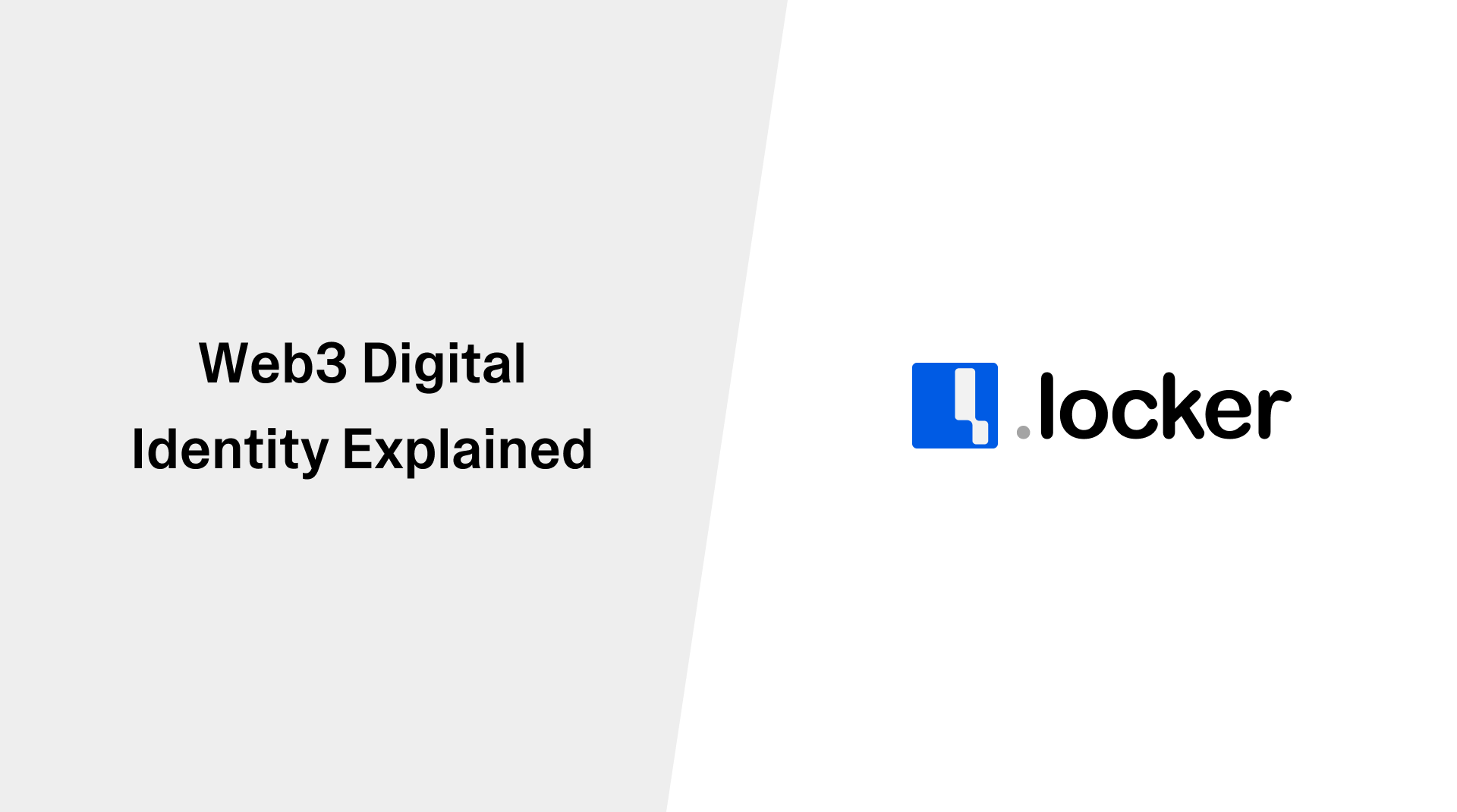Web3 Identity Explained

A digital identity is online data that is used to authenticate and verify that users are who they say they are. Digital identities often take the form of email addresses, usernames and passwords, home addresses, social security numbers, and even browsing history as they are all valid ways for someone to prove who they say they are within the digital online space.
What is Digital Identity Today?
In the Web2 system, user data storage primarily relies on a centralized identity management system (CIM). This system is when an organization like Meta or Google manages and stores all the data it owns in one centralized area.
By relying on a CIM, users can utilize mechanisms like single sign-on (SSO) to access multiple applications and websites with only a single set of credentials. However, in exchange for increased user experience, CIMs ensure that major tech companies have complete authority over people’s data.
Many online users have deemed this tradeoff unacceptable as many are uncomfortable with giving up their information or control. According to an article on CoinTelegraph, “Fifty-four percent of respondents said they were worried about their rights and freedoms are being threatened by technology, with 44% citing online privacy concerns, 38% being unhappy about online ads and 35% reporting feeling a lack of control over their data.”
Why Do We Need Blockchain For Identity?
Many online users have viewed Web3 digital identities as the potential solution for Web2’s issues and limitations. Web3 pushes digital identities to be more secure, decentralized, and fully controlled by individuals instead of centralized entities.
Unlike Web2 digital identities, which are managed on centralized platforms like servers or the cloud, Web3 ones are built on decentralized technologies like blockchains.
Key features of blockchain and how they translate to Digital Identity
The key feature that blockchains bring to identity is ownership and control over the digital ID. From this flows not just certain security and privacy properties but tradeoffs as well. For example:
- Self-Sovereign Identity: The idea of self-sovereign identity is that rather than giving centralized parties the ability to control and process our personal information, users would be in full control of their data and digital assets instead.
- Greater Privacy: Users will be able to decide what personal information they share and with whom, ensuring they only need to provide the most necessary information when logging into websites/applications or engaging with specific transactions. However, while this offers greater personal information privacy than X or Google Login can provide, it can be worse for crypto wallet privacy if a person’s digital identity is attached to a wallet that is actively used.
- Greater Security: By leveraging decentralized networks and storing their data on their own devices, users will not only have more control over their information, but also have greater protection against breaches from hackers, identity theft, and fraud. However, while it is more secure against data breaches of the large companies that own the digital identity and data associated with it, it can still be stolen if someone gets access to the wallet that owns or controls the ID.
Blockchain in Digital Identity
A blockchain is a decentralized database that securely and transparently records all transactions made between multiple parties and users. Blockchain in digital identities guarantees that users will no longer need to rely on third parties or centralized entities to manage their private information.
People will not only have full control over their data, but they can also ensure greater protection from fraud and identity theft since they will be the only owners of their individual information.
Digital Identity blockchain examples
Two notable use cases of Web3 digital identities are Ethereum Name Service (ENS) and Bitcoin Name Service (BNS). ENS and BNS are protocols that use unique identifiers to cement an online user’s identity on a blockchain. This means that once a person has selected and claimed an available name, only they have access to that specific one.
Ultimately, ENS is specifically designed for the Ethereum blockchain. BNS, however, is built on the Bitcoin blockchain and offers users the following:
- A decentralized Web3 domain name system made specifically for the Bitcoin blockchain and is registered by Stacks.
- Users can generate and manage human-readable domain names that end with the extension that ends with Bitcoin-based extensions like “.btc.”
- Domain names can be used to send and receive payments, provide seamless login capabilities, manage multiple Web3 accounts, and cannot be blocked or deleted.
ENS and BNS are just two examples as various other applications attempt to decentralize the Internet via Web3 digital identities as well.
Decentralized Identifiers and Verifiable Credentials
Blockchains are not the only Web3 technologies that have been developed to overcome the privacy, security, and control issues that have become commonplace in Web2 digital identities. Two other examples include decentralized identifiers and verifiable credentials.
What are Decentralized Identifiers (DIDs)?
Decentralized identifiers are essentially virtual driver’s licenses or passports. They can authenticate a person’s identity without forcing them to give up their personal information to a centralized group or entity.
This means that people have total control over their data and are not required to submit any of it to anyone if they so choose. DIDs also provide benefits such as:
- Sole ownership and protection. No party can take away or tamper with a user’s data.
- Increased security. The data in DIDs are protected by digital signatures, which can reduce the chances of data breaches and hacking.
Some of the most prominent decentralized identifier projects that are currently developing the latest in DID technology include:
- Polygon ID
- Lifeform
- Space ID
- Ethereum Name Service (ENS)
What are Verifiable Credentials (VCs)?
Verifiable credentials are digital versions of documents that are cryptographically protected and can be used as an additional means of verifying a person’s identity. A DID issuer often associates various VCs with a single DID. Examples of records that can become verifiable credentials include:
- Driver’s licenses
- Passports
- Employee certifications
Why Blockchain Identity Solutions are Important
Blockchain identity solutions are important because many online users see them as the future of how digital identities should be managed. They address many of the issues and challenges in traditional Web2 digital identity management systems and offer a series of benefits that are becoming increasingly necessary for modern digital identities.
These benefits include:
- Increased Privacy and User Control: Under traditional Web2 digital identity management systems, people must give up their personal information to third-party groups. This not only gives these entities control over people’s information but also leads to risks such as data overexposure. Under blockchain identity solutions, which enable self-sovereign identity, control is returned to the people. Users will have total ownership over their data and decide what and to whom they wish to share this information.
- Increased Protection: People’s information in centralized databases often becomes the target of various cyberattacks. These attacks lead to major data breaches that compromise much of that data and the owners become victims of fraud and identity theft. Blockchain identity solutions address this problem by distributing personal data across a network of nodes instead of one specific location and providing cryptographic keys to individual users. These defenses make data breaches much more difficult and significantly reduce the chances of large-scale identity theft.
- Decentralization: When user information is stored in one central database, it becomes vulnerable to corruption or loss if something happens to the database or the entity that owns it (i.e. cyberattacks, system goes offline, system failures, etc.). Fortunately, because blockchain identity solutions spread personal data through a network of nodes, they ensure that users will still have access to their data even if one or two fail or become compromised.
The Future of Digital Identity on Blockchain
Web2 is an important milestone that changed how people use the Internet, but it also comes with privacy and security issues that put their digital identities at risk. From emails to home addresses, the personal information that makes up digital identities is owned by centralized entities.
This leaves people with very little control over their data and often leaves them at risk of corruption and loss.
Thankfully, Web3 digital identities on blockchain could be the solution to these problems as it proposes a decentralized Internet in which individuals, not centralized entities, have total control over their personal data and digital identities.
Digital Identity Blockchain FAQs
What are the use cases of blockchain in identity management?
Some of the most notable use cases of blockchain in identity management include:
- Healthcare Identity Management: Patients will have total control and access to their medical history, allowing them to decide who has it. This means that if they wish to share their health records with their doctors and healthcare providers, they will have access to them seamlessly and automatically while maintaining their privacy.
- Voting and Election Systems: In the case of elections, blockchain digital identity management creates a transparent system in which voters can authenticate their identities when arriving at the polls and ensure that their votes are properly counted and cannot be changed or deleted.
- Education: Blockchains securely store any diplomas or certifications a person may have and shield them from any attempts at tampering or falsification. Therefore, employers and academic staff can quickly and seamlessly verify an applicant’s educational background and credentials. Students can also use blockchains to authenticate their identities when accessing online resources, classes, or courses.
What is meant by digital identity?
Digital identity is meant to be a collection of information that verifies and authenticates a person’s online identity. Some pieces of data that make up a digital identity include usernames and passwords, email addresses, social security numbers, phone numbers, date of birth, and even social media history.
What is ID in blockchain?
In terms of blockchain technology, ID refers to identity, specifically digital identity. People use them to verify their identities within the online digital space. Additionally, blockchains provide self-sovereign identity, which means that individual users, not centralized entities, will have full control and access to their digital identities.

Future-Proofing gTLDs with Minting as a Service
MaaS enables registries to extend their TLDs beyond traditional DNS and into blockchain-based naming systems BNS and ENS, unlocking new utility, new revenue models, and a path to long-term differentiation without sacrificing the stability of the existing Web2 ecosystem.
December 10, 2025

How .locker is Driving Real World Adoption: The Acupuncturist Case Study
One of the newest examples of how .locker bridges Web2 and Web3 doesn't come from a tech startup or a crypto-native company; instead, it originates with an old-school acupuncture practice.
November 20, 2025

Building the Internet’s Next Chapter: Reflections from ICANN84 and NamesCon
October was a whirlwind for .locker: two back-to-back events, two continents, and countless meaningful conversations that will shape the future of digital identity and the domain name industry.
November 13, 2025



